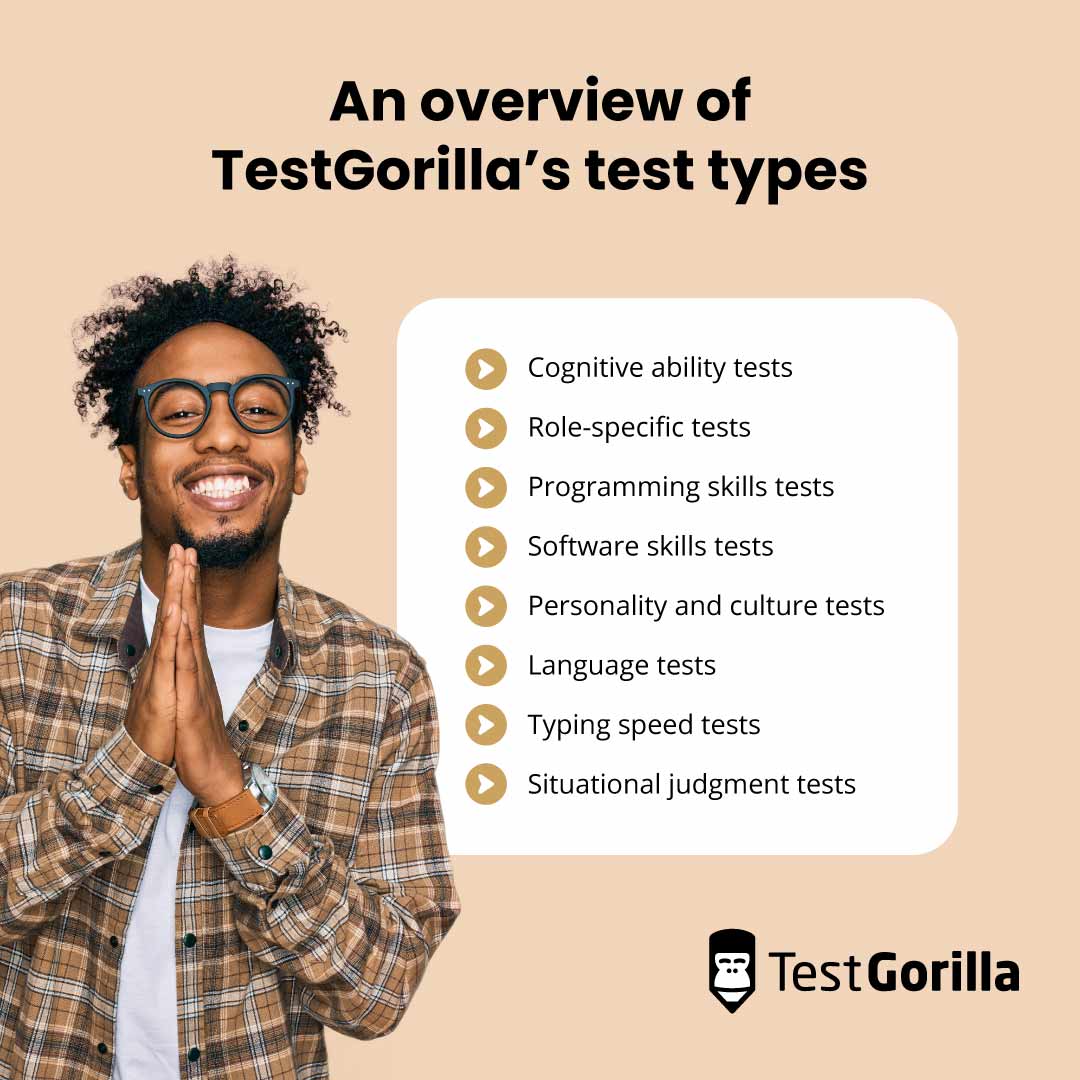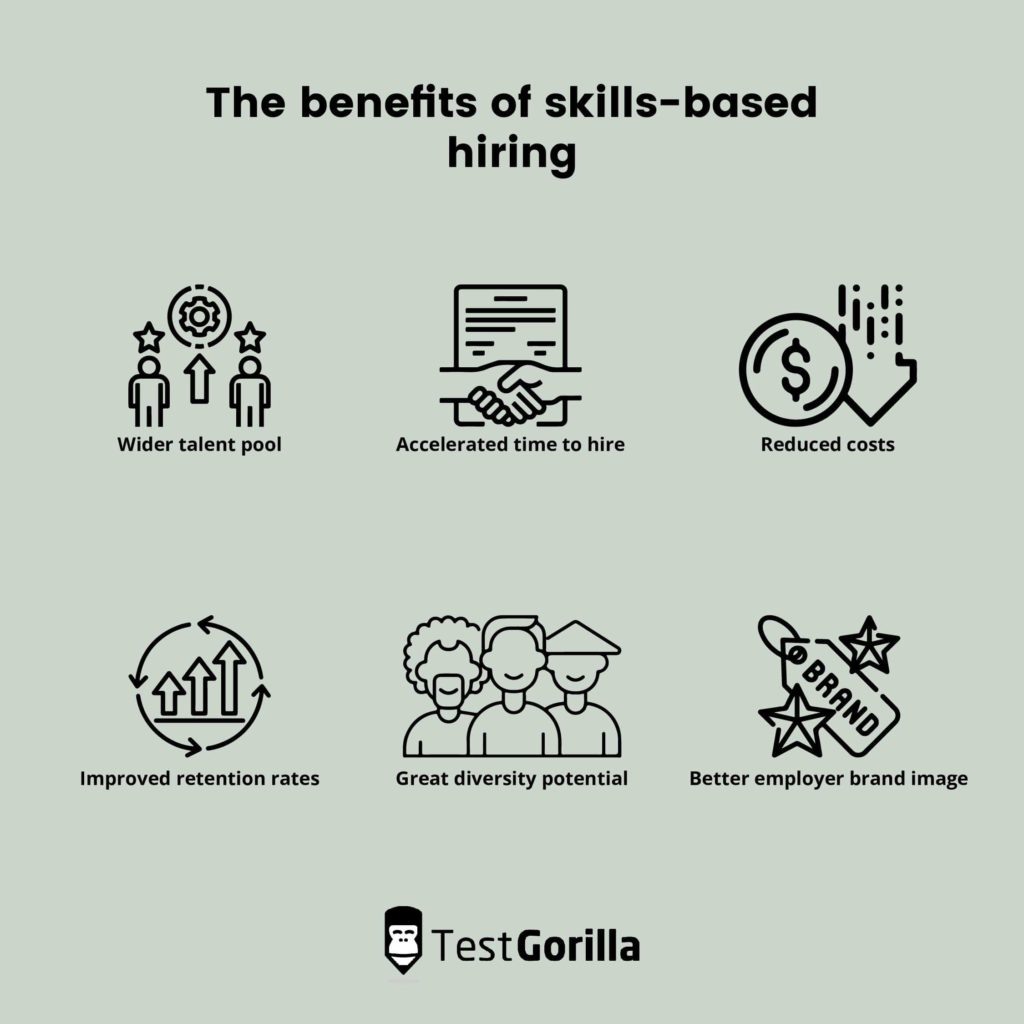Skills-based hiring is a hiring process where evidence of candidates’ skills, rather than other information such as their prior experience or where they were educated, is used to make hiring decisions. As such, employers set specific skill requirements and then measure for these skills.
We’re all about skills-based hiring at TestGorilla, and the rest of the world is finally catching up. Skills-based hiring has had lots of press of late, with big names such as Forbes, Harvard Business Review, CNBC, the BBC, and McKinsey & Company publishing content on the topic.
But what’s the long answer about skills-based hiring? How does it work? And why does it work so well? In this article, we’ll dive into the simple questions (which can have surprisingly nuanced answers) to help you understand the basics of skills-based hiring.
Table of contents
What is skills-based hiring really?
In skills-based hiring, skills reign supreme: they are more important than education or experience. As a result, skills-based hiring favors skills-based tests, which enable employers to gather real data about their candidates’ skills, over resumes.
This being said, any hiring process during which an employer asks applicants to complete a skills-based test for a job role, an assignment, or a work sample, could be considered skills-based. So, if candidates are required at any point to demonstrate their skills, and employers are using the resulting evidence of candidates’ skills (or lack thereof) to make hiring decisions, you’ve got yourself a skills-based hiring process.
This can lead to some nuances. Many employers, for example, use skills-based hiring and resumes – and lots of them conduct a resume screen before they send applicants a skills test. This might sound purist, but using skills tests this way kind of defeats the purpose of skills-based hiring.
The problem with resumes
There are best practices that should be adhered to when it comes to implementing skills-based hiring, and one of them is this: a skills-based pre-employment assessment should be conducted before resume screening. This is skills-based hiring at its most effective.
Why? Leveraging data early, and making your first decisions about which candidates to sift out using skills-based data, means you’re not pushing candidates out of your hiring funnel because of arbitrary things that don’t actually predict job success (and often lead to bias). In a true skills-based hiring process, skills – not a college degree or years of experience – come first. This is compromised when a resume screen comes before a skills assessment.
How does skills-based hiring work?
Most skills-based hiring processes hinge upon pre-employment testing. Although work samples and assignments also count as skills-based hiring, pre-employment testing is the preferred method for skills testing because it can easily be automated.
This means it’s far better suited for use at the top of the hiring funnel – sending 500 candidates an assessment is usually preferable to sending out 500 work assignments and then having to mark them.
A pre-employment assessment is a multi-measure test that is designed to identify the skills specific to the job you’re hiring for. With TestGorilla, employers can build their assessments using any of the tests in our test library. To support employers with choosing the right tests we provide assessment templates; we've also published guidance on selecting tests and avoiding skill overlap.
Once everyone has taken the assessment, employers have skills-based data for all their candidates at their fingertips. This data can be used to decide who moves through to the next stage of recruitment, and can also be leveraged much later down the line in interviews. It can even be used during onboarding and employment to make decisions about how to upskill.
What do we mean by skills?
Another nuance to the skills-based hiring picture is that there are many different ways to understand skills. It’s lengthy, but we like this definition from Deloitte:
We broadly define “skills” to encompass “hard” or technical skills (such as coding, data analysis, and accounting); human capabilities or human skills (such as critical thinking and emotional intelligence); and potential (including latent qualities, abilities, or adjacent skills that may be developed and lead to future success). Eventually, we see the word “skills” becoming short-hand for more granularly defining workers as unique, whole individuals—each with an array of skills, interests, passions, motivations, work or cultural styles, location preferences and needs, and more.
– The skills-based organization: A new operating model for work and the workforce
There is great promise in defining skills holistically like this – especially in light of the rise of AI. It’s crunch time for skills: As we learn more every day about which human skills generative AI models can and can’t replicate, it’s crucial that we define skills more holistically and humanely.
In light of this, a skills-based pre-employment assessment might test for anything from communication or empathy to coding, or even a candidate’s own Artificial Intelligence (AI) skills.
The key benefits of using skills-based hiring
Now that we’re clear on what skills-based hiring is, let's cover the key benefits. Skills-based hiring has measurable benefits in five key recruitment metrics. Based on data we gathered from 1,500 employers in 2023, we found that:
It leads to fewer mis-hires: 88% of employers using skills-based hiring reduced mis-hires
It boosts retention: 89% of employers using skills-based hiring boosted retention.
It reduces time-to-hire: 82% of employers using skills-based hiring reduced their total time-to-hire
It minimizes hiring costs: 74% of employers using skills-based hiring reduced their total hiring costs
It improves workplace diversity: 84% of employers using skills-based hiring improved workplace diversity
You can find more data like this in our 2023 State of Skills-Based Hiring report.
Why is skills-based hiring so effective?
We’ll keep this short and sweet. There are 3 reasons why skills-based hiring is so effective:
It uses data. Not a bias for graduates from certain schools, or the assumption that years of experience is predictive of job success; and not information on a resume that might be false. Skills-based hiring leverages cold, hard data to drive effective hiring decisions: this is the key to its effectiveness.
It reduces bias. It’s no secret that various biases can influence hiring outcomes for the worse, filtering out talented candidates with certain backgrounds and identities. Diverse teams perform better for a reason – eliminating bias from the hiring process is well and truly in employers’ interests. And skills-based hiring can help them do it.
It offers candidates a job preview. There’s a candidate side to this picture, too. Candidates prefer skills-based hiring: 86% of them told us it can help them secure their dream jobs. An assessment gives your candidates a taste for exercising the skills of the job, and an opportunity to reflect on whether they’d enjoy it or not. It also gives them more of a chance to shine than a single piece of paper does.
Want to learn more about skills-based hiring?
If this has piqued your interest in skills-based hiring, then you’re in the right place. TestGorilla has a range of educational materials about skills-based hiring, created to help people understand what it is, what its benefits are, and how to implement it effectively.
As a next step, we recommend reading:
The State of Skills-Based Hiring 2023 (coming soon!)
10 stories that demonstrate the power of skills-based hiring
Skills-based hiring around the world: Who’s leading the charge?
Anything from our science series!
Oh, and it’s free to sign up for TestGorilla, so you can always get started with a free plan and try out our skills-based hiring platform for yourself, for free. Did we mention it’s free?
Related posts
Hire the best candidates with TestGorilla
Create pre-employment assessments in minutes to screen candidates, save time, and hire the best talent.
Latest posts
The best advice in pre-employment testing, in your inbox.
No spam. Unsubscribe at any time.

Hire the best. No bias. No stress.
Our screening tests identify the best candidates and make your hiring decisions faster, easier, and bias-free.
Free resources
This checklist covers key features you should look for when choosing a skills testing platform
This resource will help you develop an onboarding checklist for new hires.
How to assess your candidates' attention to detail.
Learn how to get human resources certified through HRCI or SHRM.
Learn how you can improve the level of talent at your company.
Learn how CapitalT reduced hiring bias with online skills assessments.
Learn how to make the resume process more efficient and more effective.
Improve your hiring strategy with these 7 critical recruitment metrics.
Learn how Sukhi decreased time spent reviewing resumes by 83%!
Hire more efficiently with these hacks that 99% of recruiters aren't using.
Make a business case for diversity and inclusion initiatives with this data.





















